Amphibian Glossary
| Aestivation: | See estivation. |
| Albino (albinism): |
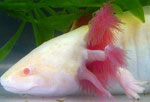 Color mutant in which the dark pigments (melanin)
are not developed. Animals are usually white or yellow with pink eyes.
Color mutant in which the dark pigments (melanin)
are not developed. Animals are usually white or yellow with pink eyes.
Photo: albino axolotl (©John Clare). |
| Amelanistic: | Lacking melanophores, which produce dark brown/black pigment often leading to very pale individuals (which may still have other colors present). |
| Ammonia or ammonium: | A toxic product (chemical formula NH3 or NH4+) produced by uneaten food and feces in an aquarium. The ideal ammonia level in a well-established aquarium is zero. See cycling. |
| Amphibian: |
All living tetrapods (four-legged vertebrate animals) that typically possess a larval stage (although not always), lack protective membranes around the egg and are ectotherms. They display a wide range of life histories from fully aquatic to fully terrestrial but generally have an aquatic and terrestrial phase. The three groups within Amphibia are: Anura (frogs), Caudata (salamanders), and Gymnophiona (rubber eels). |
| Amphipods: | Small, mostly benthic crustaceans somewhat resembling isopods in shape and form. These organisms crawl or swim and are abundant in many marine and freshwater habitats. |
| Amplexus: |
 Reproductive behavior in which the male grasps the
female in a hold; from the Latin for "embrace". The grasping
method varies by species.
Reproductive behavior in which the male grasps the
female in a hold; from the Latin for "embrace". The grasping
method varies by species.
Photo: Taricha granulosa in amplexus (©Ian Rigg).
|
| Anura/anuran: | The frogs and toads. The word "anuran" means "without tail", as these amphibians lack a tail in adulthood. |
| Apoda: | See caecilian. |
| Aposematic coloration: |
 Bright coloration or color patterns that serve as a conspicuous
warning to predators that the potential prey may be dangerous, toxic,
or foul-tasting.
Bright coloration or color patterns that serve as a conspicuous
warning to predators that the potential prey may be dangerous, toxic,
or foul-tasting.
Photo: Dendrobates imitator demonstrating aposematic coloration (©John Clare). |
| Aqua-terrarium: | An aquarium that has a portion of land area. Approximate synonyms include paludarium and vivarium. |
| Aquarium: | A tank or enclosure containing water in which aquatic animals and/or plants live; normally a container with transparent sides. |
| Arboreal: | Adapted for living in trees. |
| Artemia/brine shrimp: | Artemia salina or related species of crustaceans, commonly known as brine shrimp. Inhabit hyper-saline waters such as Utah's Great Salt Lake. Eggs in their dry state (cysts) resemble brown powder and are commonly sold to be hatched as food for baby fish and also work well for caudate larvae (see BBS). Adults are sold frozen or live and can be fed to aquatic adult caudates. |
| Axanthic: | Lacking xanthophores, which produce yellow pigment, usually leading to a dark individual. |
| Balancer: |
 Rod-like structures on each side of the head of newly-hatched
larvae. The balancers allow the larva to sit in an upright position. Once the forelimbs develop, the balancers disappear.
Rod-like structures on each side of the head of newly-hatched
larvae. The balancers allow the larva to sit in an upright position. Once the forelimbs develop, the balancers disappear.
Photo: newly-hatched larva with balancer visible (©Mark Aartse-Tuyn). |
| Batrachochytrium dendrobatidis: | A fungus of the class Chytridiomycetes that causes the disease chytridiomycosis in amphibians; often abbreviated as Bd or referred to as 'chytrid' (pronounced KIT-rid). |
| BBS: | Abbreviation for baby brine shrimp, also called brine shrimp nauplia. |
| Bd: | See Batrachochytrium dendrobatidis. |
| Benthic: | The benthic zone of an aquatic system refers to the bottom surface and water directly above it, often out of the reach of sunlight. Commonly, invertebrates live here and feed on detritus. Many caudate larvae are benthic, remaining on the bottom surface. |
| Blackworms: |
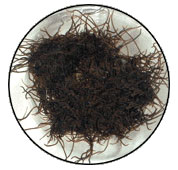 Small freshwater worms, usually of the species Lumbriculus
variegatus; an excellent food for many salamanders, especially
larval and aquatic forms. Similar to Tubifex, but blackworms are larger and darker in color. Available commercially in North America, but not Europe. Small freshwater worms, usually of the species Lumbriculus
variegatus; an excellent food for many salamanders, especially
larval and aquatic forms. Similar to Tubifex, but blackworms are larger and darker in color. Available commercially in North America, but not Europe.
Photo: live blackworms (courtesy Aquaticfoods.com). |
| Bloat: | A common symptom of illness in amphibians. Affected animals have obvious fluid retention and swelling of the body. The root cause is organ failure, usually subsequent to internal infection, dehydration, poor water quality, or other problem. For details, see Bloat in Newts article. |
| Bloodworm: |
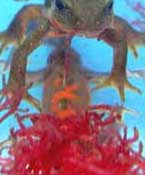 Larval form of a midge. They are really insects, not
worms and are usually sold frozen, but available live in some places.
Bloodworms are noted for their bright red color. Some pet shops use
the word "bloodworm" incorrectly to refer to blackworms.
Larval form of a midge. They are really insects, not
worms and are usually sold frozen, but available live in some places.
Bloodworms are noted for their bright red color. Some pet shops use
the word "bloodworm" incorrectly to refer to blackworms.
Photo: Cynops pyrrhogaster eating frozen bloodworms (©Tim Johnson). |
| Brine Shrimp: | See Artemia |
| Brumation: | A state of cold-period dormancy or reduced activity in cold-blooded animals. Unlike hibernation, the animal may remain partially active during brumation. |
| Caecilia/caecilian: |
 A poorly-known group of limbless worm-like amphibians, also known as "rubber
eels". For more information, see Gymnophiona.org.
A poorly-known group of limbless worm-like amphibians, also known as "rubber
eels". For more information, see Gymnophiona.org.
Photo: a caecilian, Ichthyophis kohtaoensis (©Chris Michaels). |
| Carnivore (adj, carnivorous): | An animal that feeds only on other animal organisms. In contrast, omnivores eat both plants and animals, and herbivores eat only plants. Nearly all salamanders are strictly carnivorous. |
| Cattle Tank (American): | A term used to describe a depression in the ground (usually a relatively "bare" shallow pond) from which cattle can drink. On the Great Plains in the USA these are often important amphibian habitats due to the scarcity of natural water bodies. |
| Caudal: | Referring to the tail or tail area of an animal. |
| Caudal fin: |
 The fin that extends along the tail of many aquatic animals, including caudate larvae. An extended caudal fin grows on some male caudates
during the breeding season; most markedly seen in the crested newts
(Triturus) although they are seen to a lesser degree in other caudates as well. The
fins are associated with visual, tactile and chemosensory courtship
behavior and may be combined with the development of bright
colors, thus increasing the surface area of coloring.
The fin that extends along the tail of many aquatic animals, including caudate larvae. An extended caudal fin grows on some male caudates
during the breeding season; most markedly seen in the crested newts
(Triturus) although they are seen to a lesser degree in other caudates as well. The
fins are associated with visual, tactile and chemosensory courtship
behavior and may be combined with the development of bright
colors, thus increasing the surface area of coloring.
Photo: Male Notophthalmus viridenscens with extended caudal fin during breeding season (©Isaiah Connell). |
| Caudata/caudate: | Caudata or Urodela is the scientific name for the salamanders. The word caudate means "tail", as these amphibians possess a tail throughout their life. |
| CB: | Abbreviation for captive bred. Sometimes also written as CBB (captive born and bred) to distingish from captive-born animals (born in captivity from recently wild-caught adults that bred in the wild). |
| Chironomid: | A family of non-biting midges. See bloodworm. |
| Chromatophore: | Pigment-containing cell of the skin. There are several different kinds of chromatophores, each containing different types of pigment(s). These include melanophores (containing melanin, a brown-black pigment), iridophores (containing crystals that impart a shiny iridescence), and xanthophores (containing carotenoids and pteridines, yellow and reddish pigments). For more information, see Axolotl.org Genetics and Colour page. |
| Chytrid Fungus: | See Batrachochytrium dendrobatidis. |
| Chytridiomycosis: | A disease caused by the fungus Batrachochytrium dendrobatidis. It is thought to be responsible for amphibian declines throughout the world and in some cases mass extinction. The fungus infects the outer layer of skin and may cause thickening of the epidermis, blistering and sloughing. The spores of the fungus are easily spread through water and thrive at cool temperatures. Some species have been shown to be resistant to the disease. |
| Cirrus (plural cirri): | A fleshy downward extension of the upper lip that encompasses the nasolabial groove; occurs on some Plethodontid salamanders and functions in chemoreception. See Sexing article. |
| CITES: | Acronym for the Convention on International Trade of Endangered Species. CITES regulates the trade of protected species (endangered and threatened). There are three articles to CITES (I, II, and III), which indicate how endangered a species is. Animals listed in CITES cannot be traded internationally without permits, regardless of their origin. CITES was drafted as a result of a resolution adopted in 1963 at a meeting of members of IUCN. |
| Cloaca: | The glandular posterior-ventral opening shared by the alimentary canal, reproductive system, and urinary tract. During breeding season the cloaca of some male caudates may swell due to the enlargement of the cloacal glands; see Sexing article. |
| Common Name: | Names that vary between languages or geographical areas used to describe a particular species or subspecies of an animal such as eastern newt or barred tiger salamander, respectively. Capitalization of common names is not required. |
| Conspecific: | (1) Of or belonging to the same species or subspecies, whichever applies. (2) Multiple like specimens kept in the same enclosure. Example: Conspecific nibbling is very common among many caudate larvae. |
| Copepods: | Small crustaceans that somewhat resemble shrimp. There are many species, both freshwater and marine. Copepods swim with a 'jerky' motion and are an important link in many aquatic food chains. Most familiar to newt keepers is Cyclops. |
| Costal Grooves: |
 Grooves on the flanks and dorsum of some salamanders
which increase the surface area of the skin for water absorption and
provide cutaneous channels which allow water to move up to the dorsum
by capillary action.
Grooves on the flanks and dorsum of some salamanders
which increase the surface area of the skin for water absorption and
provide cutaneous channels which allow water to move up to the dorsum
by capillary action.
Photo: Ambystoma jeffersonianum showing distinct costal grooves (©Mike Grazianos). |
| Crepuscular: | Most active during twilight hours at dawn and dusk. The term 'activity' refers to natural or normal functions and may include: movement, feeding, hunting, migration, breeding, nest building, etc. |
| Critically Endangered: | See IUCN Red List Categories. |
| Cycling: | (1) The breakdown of waste products in an aquarium.
Waste products produce ammonia,
which is subsequently broken down by beneficial bacteria in the presence
of oxygen. The ammonia is converted to nitrite
and then into nitrate. An aquarium
is considered to be "cycling" (or "cycled") when
the beneficial bacteria have become well-established, a process that
takes one month or more after a new aquarium has been set up. See Cycling article.
(2) The seasonal changes that prepare an animal for reproduction. For example, a salamander may need to be exposed to a cold winter and decreased sunlight in order to be properly cycled for breeding in the spring. |
| Cyclops: | A familiar freshwater copepod. It swims with 'jerky' motion and is named for the presence of a single eye. |
| Daphnia: |
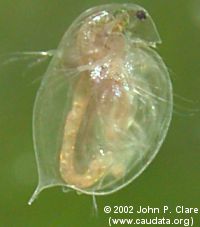 Small crustaceans that usually inhabit the open, sunlit
waters in freshwater environments. Daphnia are known for their 'jerky'
swimming motion and are also referred to as water fleas. Their small
size makes them an ideal and natural food for aquatic salamanders
and larvae.
Small crustaceans that usually inhabit the open, sunlit
waters in freshwater environments. Daphnia are known for their 'jerky'
swimming motion and are also referred to as water fleas. Their small
size makes them an ideal and natural food for aquatic salamanders
and larvae.
Photo: Daphnia magna (©John Clare). |
| Detritivores: | Scavengers that eat dead plant and animal material. Healthy aquariums contain an assortment of detritivores, which transform aquarium detritis into mulm. Soil-based terrariums also contain detritivores. Detritivores range in size from microscopic to easily-seen, and include creatures such as protozoa, tiny worms, snails, etc. See Tank Critters article. |
| Detritus: | Organic matter derived from dead or decaying plants and animals and their waste products (e.g., skin cells, feces, etc.). Detritus serves as a food source for bacteria, fungi, and certain aquatic and terrestrial animals (see Tank Critters). In a healthy aquarium, detritus breaks down into mulm. |
| Dimorphism: | The occurrence of two distinct forms of coloring, structure,
size, or other characteristics in a single species. Sexual dimorphism
occurs where dimorphism exists between males and females. The following
are examples:
|
| Diploid: | Having paired sets of chromosomes in a cell or cell nucleus i.e., two sets of chromosomes or twice the haploid number. In diploid organisms that reproduce sexually, one set of chromosomes is inherited from each parent. |
| Diurnal: | Most active during daylight hours. The term 'activity' refers to natural or normal functions and may include: movement, feeding, hunting, migration, breeding, nest building, etc. |
| Dorsal: |
Referring to the top (or back) part of the animal. This would correspond to the spinal region.
|
| Dorsal fins: | Extended fins grown on some male caudates during the breeding season; most markedly seen in the crested newts (Triturus) although they can be seen in other caudates as well. The fins are associated with visual, tactile and chemosensory courtship behavior and are normally combined with the development of bright colors thus increasing the surface area of coloring; see Sexing article. |
| Dorsolateral: |
 Relating to structures or markings that run along the
sides of an animal's back.
Relating to structures or markings that run along the
sides of an animal's back.
Photo: Mandarin newts (Tylototriton shanjing) have prominent dorsolateral warts (©Heather Bjornebo). |
| Drosophila: | Also known as the fruit, vinegar, or pomace flies of the genus Drosophila (not to be confused with certain flies that share the common name fruit fly). Drosophila is commonly cultured as food for surface feeding fish, small amphibians and reptiles, etc. They are easily cultured in large numbers in a small space. |
| Ectotherm/Ectothermic: | An organism that must use heat acquired from the environment and behavioral adaptations to regulate body temperature. Also known as "cold-blooded", these animals' body temperature varies with the temperature of their surroundings. Amphibians are ectotherms. |
| Eft: |
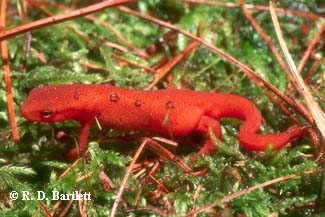 A juvenile newt in its fully-terrestrial stage of development, e.g.,
the reddish-orange terrestrial form of the North American species
Notophthalmus viridescens.
A juvenile newt in its fully-terrestrial stage of development, e.g.,
the reddish-orange terrestrial form of the North American species
Notophthalmus viridescens.
Photo: Eastern newt (Notophthalmus viridescens) eft (©R. D. Bartlett). |
| Endangered: | See IUCN Red List Categories. |
| Endemic: | A term referring to a taxon restricted to a specific region or location. |
| Estivation (aestivation): | A state of dormancy during heat or drought periods. Characterized by low metabolic activity and formation of a protective cocoon made of skin secretions or layers of shed skin. |
| Erythristic: | Having a greater amount of red coloration than usual. |
| Exotic: | See Introduced. |
| External fertilization: | The fusion of the male and female gametes occurs outside of the animals' body usually in an aquatic environment. These animals spawn or release their gametes into the water and by random chance the gametes join and fuse. Anurans and egg-laying fish are examples of animals that reproduce in this fashion. |
| Extinct: | See IUCN Red List Categories. |
| Extirpation: | Within the context of animals and plants, extirpation means the eradication of a species or subspecies from a portion of its natural range. |
| Field Herping: | Describes the hobby/passion of looking for 'herps' (reptiles/amphibians) in the wild...whether for photography, study, or simple enjoyment. |
| Filtration: | Cleaning water to remove unwanted elements. There are three subtypes of filtration: mechanical, biological and chemical, and any combination of these can occur in a single filter. See Filters for Aquatic Caudates. |
| Flavistic: | A color mutant that has a yellow or golden color. |
| Fossorial: | Adapted for digging and living underground (e.g., Ambystoma sp.). |
| Gammarus: | A type of amphipod commonly found in the bottom sediment in freshwater environments. Good tank scavengers and a favorite food of many newts. They can be cultured for fish and newt food. Common names: scud or freshwater shrimp. |
| Genus: | The taxonomic group that is more inclusive than species and less inclusive than family. In the scientific name for a species, the genus name is first and the first letter is capitalized; this is followed by the all-lowercase species and where applicable, subspecies name. |
| Gymnophiona: | See caecilian. |
| Haploid: | A term used to describe the state of having only one set of chromosomes (paternal or maternal) in a cell's nucleus. Most animal cells have two sets of chromosomes (diploid), with the general exception of the gametes (cells produced for sexual reproduction). See also polyploid. |
| Harlequin: | See piebald. |
| Hibernation: | A state of cold-period dormancy in mammals. Cold-blooded animals are sometimes said to "hibernate", but the correct term is brumation. |
| Holotype: | A biological specimen preserved at the time that a new species is described and designated to serve as the defining example. It is chosen by the describer and deposited at a museum, university, or other public respository. |
| Hyallela: |
 A type of amphipod. See also Gammarus. Common names: scud or freshwater shrimp.
A type of amphipod. See also Gammarus. Common names: scud or freshwater shrimp.
Photo: Hyallela sp. (©Jennifer Macke). |
| Hybrid: | The offspring of parents of different species, e.g., Ambystoma jeffersonianum complex or complex of hybrid Ambystoma species. See also Unisexual. |
| Hypermelanistic: | An animal with an increased amount (or distribution) of melanin in the skin, giving it a color that is significantly darker than normal. |
| Hypomelanistic: | An animal with a reduced amount of melanin in the skin, giving it a color that is significantly lighter than normal. |
| Indigenous: | Meaning the organism is 'native to' or 'of geographical origin from' a particular country, region or locality. Contrast with introduced. |
| Infrasubspecific: | Refers to a category or name of lower rank than subspecies. For example: form, race and variety. |
| Infusoria: | A collective term for minute aquatic creatures like ciliates, euglenoids, protozoa, and unicellular algae that exist in freshwater ponds. However, in formal classification microorganisms called infusoria belong to the Kingdom Protista. Infusoria are used by keepers of aquariums to feed fish fry; gourami fry and tadpoles are just two examples which will require this food to survive the first few days of life. However, there are usually not enough infusoria in the average aquarium tank to feed the newly hatched animals. |
| Internal fertilization: | The fusion of the male and female gametes occurs within the female's reproductive tract either through copulation (mammals) or cloacal fertilization (examples include caecilians, most salamanders and many reptiles). |
| Introduced: | Refers to a species that has been relocated and that has established populations in regions outside of its natural range (most frequently through human intervention). This is also sometimes referred to as exotic or invasive. |
| Invasive: | See Introduced. |
| Invertebrate: | An animal which lacks an internal skeleton. Invertebrates either have an exoskeleton (e.g., insects and spiders) or no skeleton (e.g., worms). For amphibians, invertebrates are a naturally occurring food source and comprise much of their diet. |
| Iridophore: | A pigment-containing cell that contains crystals that impart a shiny iridescence. See chromatophore. |
| IUCN: | Acronym for the International Union for Conservation of Nature which was founded in 1948 and was the first international environmental organization. IUCN unites governments, scientists and other organizations to ensure passage of protective laws, best practices, and a unified standard of conservation worldwide. This organization is responsible for the Red List that identifies threatened and endangered species on an international level. See. |
| IUCN Red List Categories: |
Reference |
| Java moss: | A semi-aquatic moss (now known as a Taxiphyllum sp., but usually referred to as Vesicularia dubyana) that is popular with aquarium hobbyists for its many benefits in use in the aquarium/paludarium. Java moss is particularly suited to caudate paludariums due to its tolerance of low light, tolerance of cold temperatures, and ability to grow across surfaces slightly above the water line. |
| Kleptogenesis: | A method of reproduction whereby a female 'steals' sperm from a sympatric sexual male. The sperm is required to stimulate an egg to divide (gynogenesis) but does not fertilize the egg and may or may not contribute chromosomes to the offspring. Unisexual Ambystoma utilize this unique method of reproduction. This is a parthenogenesis-like process in that the egg is not fertilized by a male. The need for sperm stimulation, however, is not required in parthenogenesis. |
| Larva: | A free-living, sexually immature form of caudates, as well as many invertebrates and fish. Larvae hatch from an egg and they do not resemble the adults until after they go through metamorphosis. Larvae may differ from adult animals in many ways including diet, habitat and morphology. |
| Lateral: |
Referring to the side(s) of an animal.
|
| Laterally compressed: | An anatomical description of something compacted from the sides. This term is often used to describe the fin-like tail shape of aquatic and semi-aquatic caudates. |
| Least Concern: | See IUCN Red List Categories. |
| Lectotype: | A definitive type specimen selected from among the originally-preserved specimens because the original species describer did not designate a holotype. See also Neotype. |
| Leucistic: |

Photo: leucistic axolotl (©John Clare). |
| Littoral: | The littoral zone is the area of an aquatic system where light can penetrate the water all the way to the substrate. This is the 'shore' area, often dominated by vegetation rooted in the substrate and emerging from the water (like cattails). |
| Limnetic: | The limnic zone of an aquatic system is the open water in the middle of a body of water, at a depth where light still penetrates. |
| LTC: | Abbreviation for long-term captive. Usually refers to wild-caught animals. |
| Melanin: | Brown-black pigments that give color to the skin of many amphibians and is produced in epidermal cells called melanophores or melanocytes. |
| Melanistic (or melanoid): | Color mutant where the shiny pigment cells (iridophores) are not developed. Melanoid axolotls are sometimes darker in color than normal and lack the shiny ring around the eyes. |
| Melanophore: | A pigment-containing cell that contains melanin, a brown-black pigment. See chromatophore. |
| Mental Gland: |
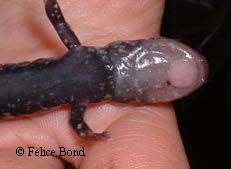 Circular glands found on the chin of most male plethodontids.
These are brought into contact with the female during courtship; see Sexing article.
Circular glands found on the chin of most male plethodontids.
These are brought into contact with the female during courtship; see Sexing article.
Photo: Mental gland (©Felice Bond). |
| Metamorphosis: | A series of postembryonic changes involving structural,
physiological, biochemical, and behavioral transformations. In amphibians,
these changes are of three main types:
1. Regression of structures and functions that are significant
only to the larvae In most amphibians there is a profound change between larval and
adult forms. |
| Morph: | 1. Colloquial shorthand for "metamorph" or "metamorphosis". 'Morph' is often used to refer to newly-metamorphosed juvenile caudates. 2. The more correct meaning of the term 'morph' is when used as an abbreviation for morphotype. |
| Morphotype (often abbreviated to morph): | A term used to describe an infrasubspecific group of animals distinguishable from other animals of the same species or subspecies on the basis of morphologic characters. For example, the cannibalistic morph of Ambystoma mavortium mavortium has a wider, flatter head, with an extra row of vomerine teeth which are often recurved. |
| Mulm: | The end-product of fully decomposed detritus in an aquarium. Mulm appears as brown debris, usually under gravel. |
| Nasolabial grooves: | Grooves found on the face of plethodontids that run from the nose to the mouth. During the breeding season they become elongated and a protuberance grows, known as cirri, where the groove meets the lip. These are thought to aid male salamanders to "smell" females in the area and avoid other males; see Sexing article. |
| Nauplia: | Newly-hatched brine shrimp. |
| Near Threatened: | See IUCN Red List Categories. |
| Neoteny (neotenic): | Retention of larval or juvenile characteristics in sexually mature adult individuals. In these individuals, the rate of development of certain somatic parts of the body is slowed whereas development of reproductive organs and the rest of the somatic body proceed normally. The number of larval/juvenile characteristics that are retained is very variable. |
| Neotype: | A definitive type specimen selected subsequent to the original species description. This may occur because the original species describer did not designate a holotype, or because the holotype has been lost or destroyed. See also Lectotype. |
| Night crawler: | American term for the large earthworm, Lumbricus terrestris. Also spelled as a single word, nightcrawler. |
| Nitrate: | The non-toxic product (chemical formula NO3) produced by the breakdown of ammonia and nitrite in an aquarium. While not toxic, high nitrate levels (>50 ppm) in an aquarium indicate the need for larger partial water changes on a regular basis. See cycling. |
| Nitrite: | A toxic product (chemical formula NO2-) of the breakdown of ammonia in an aquarium. The ideal level of nitrite in a well-established aquarium is zero. See cycling. |
| Nocturnal: | Most active at night during darkness (most caudates are nocturnal). The term 'activity' refers to natural or normal functions and may include: movement, feeding, hunting, migration, breeding, nest building, etc. |
| Nuptial pads: |
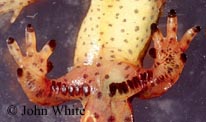 Rough, keratinized pads found on the chest or limbs
of male caudates that allow them
to maintain a grip on the female during amplexus; see Sexing article.
Rough, keratinized pads found on the chest or limbs
of male caudates that allow them
to maintain a grip on the female during amplexus; see Sexing article.
Photo: Nuptial pads on the legs of a male Notophthalmus viridescens (©John White). |
| Oviparous: | Reproduction through laying eggs that develops and hatches outside of the mother's body. Embryos are nourished by the egg yolk. Most anurans and caudates are oviparous. |
| Ovoviviparous: | Reproduction through eggs that develop within the mother and young are born live or immediately after the eggs are deposited. Embryos are nourished by the egg yolk. Examples would include certain salamanders (e.g., Salamandra sp.) some reptiles and insects as well as some fish. |
| Paedomorphism: | Phenomenon by which the reproductive organs mature earlier in the development than would be "normal". The result is an immature (e.g., larval, juvenile or sub-adult) individual with the capacity of reproducing. |
| Paludarium: | An aquarium that has a portion of land area. Approximate synonyms: aqua-terrarium, vivarium. |
| Papillae: |
 Small projections of skin that line the opening of the male's
cloaca, normally associated
with glandular swelling during breeding season. These hair-like projections may sometimes protrude from the cloaca. See Sexing article.
Small projections of skin that line the opening of the male's
cloaca, normally associated
with glandular swelling during breeding season. These hair-like projections may sometimes protrude from the cloaca. See Sexing article.
Photo: Papillae extending from the cloaca of a male Cynops ensicauda popei (©Tim Johnson). |
| Parotoid gland: |
 An external skin gland with a concentration of pores capable
of excreting a milky mixture of toxins and irritants as a defense
against predators. It is found in some salamanders and toads. Parotoid
glands occur as a pair, one behind each eye. In toads they are located
above the tympanum. The parotoid gland is not to be confused with
the parotid gland; the two are unrelated in form and function.
An external skin gland with a concentration of pores capable
of excreting a milky mixture of toxins and irritants as a defense
against predators. It is found in some salamanders and toads. Parotoid
glands occur as a pair, one behind each eye. In toads they are located
above the tympanum. The parotoid gland is not to be confused with
the parotid gland; the two are unrelated in form and function.
Photo: The parotoid gland is often pronounced in Salamandra species. (©Mike East). |
| Perennibranch: | Perennibranchiate salamanders have gills for their entire lives. Examples include the Axolotl (Ambystoma mexicanum) and Mudpuppy (Necturus maculosus). Giant salamanders, such as the Hellbender (Cryptobranchus alleganiensis spp.) and other Cryptobranchids (Andrias japonicus and A. davidianus) can also be referred to as perennibranchiate. The clue here is in the name: "Cryptobranchus" - Hidden Gill. These salamanders have folds of skin that effectively act as external gills, but the fact that they work like gills is not obvious to the eye, hence the name. |
| Piebald: |
 A leucistic axolotl
in which some pigment occurs on the body, often in specks or blotches.
Synonym: harlequin. A leucistic axolotl
in which some pigment occurs on the body, often in specks or blotches.
Synonym: harlequin.
Photo: A piebald axolotl (©Jacob Bidinger). |
| Polyploid: | A term used to describe the state of having more than the "normal" two sets of chromosomes in a cell nucleus (a cell or animal with two sets is known as diploid). There are many states of polyploidy and they are named according to the Greek numerical prefix for the number of sets of chromosomes present: triploid describes a cell or animal with three sets; tetraploid describes a cell or animal with four sets; pentaploid is five sets; hexaploid is six sets; heptaploid is seven and so on. An example would be salamanders from the Unisexual Ambystoma Complexes which can be diploid, triploid, tetraploid or pentaploid. These polyploid female salamanders are considered to reproduce by kleptogenesis. See also haploid. |
| Predator: | An animal that lives by preying on and capturing live animals to eat. Nearly all salamanders are predators and strictly carnivores. |
| Premaxillary teeth: | Sexual dimorphism found in Plethodontid salamanders whereby males have elongated front teeth that sometimes protrude through the lip. These are used to deliver secretions from the mental gland during courtship behavior. |
| Red List: | A list of endangered and threatened species; see also IUCN Red List Categories. The best-known red list is maintained by the World Conservation Union (IUCN). Individual countries or states may also maintain their own red lists. |
| Salamander: | The general term for all caudates, a group of animals that includes the newts, sirens, amphiumas, mudpuppies, waterdogs, olms, hellbenders, etc. |
| Salienta: | Another term for anuran. |
| Scavenger: | An animal that feeds on dead organisms, especially carnivores that eat dead animals rather than hunting live prey. |
| Scientific Name: | A pair of words that refers to a particular animal species. These names are agreed upon by international bodies of scientists and are used in multiple languages. Proper writing of scientific names includes using a different font (italics) and the first word of the pair (the genus name) is capitalized while the second word (the species name) is not. Subspecies names are also not capitalized. After a scientific name has been used once in a piece of writing it is acceptable to shorten the name by using the initial of the genus (and where there are subspecies, also using the initial of the species) i.e., Cynops orientalis shortens to C. orientalis and Salamandra salamandra salamandra shortens to S. s. salamandra. Scientific names are also referred to as: Latin names, binomial, binomial name, binominal, binominal name, and species name. |
| Scud: | The common name for some freshwater shrimp or amphipods. Two common varieties are Gammarus and Hyallela. |
| Seepage: |
 A place where groundwater is trickling/seeping from the
ground. Usually, a seepage is on the side of a hill, cliff, etc., and
often in association with a spring or creek bed. The seepage itself
is usually not big enough to be considered a small spring or creek,
but has enough water flowing to be continually dripping or wet. In
the southern USA, you'll often hear seepage referred to as a "steephead".
They can be permanent or seasonal.
A place where groundwater is trickling/seeping from the
ground. Usually, a seepage is on the side of a hill, cliff, etc., and
often in association with a spring or creek bed. The seepage itself
is usually not big enough to be considered a small spring or creek,
but has enough water flowing to be continually dripping or wet. In
the southern USA, you'll often hear seepage referred to as a "steephead".
They can be permanent or seasonal.
Photo: A seepage in Oregon with lush mosses and vegetation (©Jennifer Macke). |
| Sexual dimorphism: | See dimorphism. |
| Sexual reproduction: | Achieved through the process of fertilization i.e., the fusing of cell nuclei from a male gamete (sperm) and a female gamete (egg) to produce a zygote which through various stages of development produces an adult. Fertilization is achieved through either internal fertilization or external fertilization. |
| Spermatophore: |
 A small gelatinous mass deposited by a male newt or salamander
during courtship. At the tip of the mass is a spermatozoa packet,
which is picked up by the female's cloaca
(depending on the success of the male's courtship) leading to internal fertilization.
A small gelatinous mass deposited by a male newt or salamander
during courtship. At the tip of the mass is a spermatozoa packet,
which is picked up by the female's cloaca
(depending on the success of the male's courtship) leading to internal fertilization.
Photo: Spermatophore from an axolotl (©Stjepan Puric). |
| Substrate: | The material at the bottom of an enclosure. Most terrestrial enclosures have a substrate of damp paper towels, topsoil, leaf litter, coconut fiber, or a mixture of different materials. Aquatic tanks may have a substrate consisting of sand, gravel, river rocks, slate, or some other non-soluble material. A substrate should be chosen for the needs of the species and the keeper: appropriate size, natural appearance, compatibility with live foods, ease of cleaning, etc. |
| SVL (snout-vent length): | Distance from the tip of the snout to the posterior margin of the cloaca. See also TL. |
| Sympatric: | Two or more groups, species, etc., that have overlapping ranges and occupy the same geographic location. |
| Tadpole: | The larval form of an anuran. There is no special word for the larval form of a caudate; they are simply called larvae. |
| Taxon (plural taxa): | Kingdom, phylum, class, order, family, genus, and species are the main taxa from highest and broadest to lowest and narrowest. These may also be modified by the prefixes super-, sub- and infra- which denote a rank above the taxa, beneath the taxa and beneath the subtaxa, respectively. The term taxon/taxa may also be used in situations where there could be uncertainty about whether the animal(s) in question are a single species, subspecies, or a group of related species. |
| Terrarium: | A terrestrial environment for animals and/or plants. Usually contains soil or a soil-like substrate. |
| Terrestrial: | Living on or in the ground. |
| TL (total length): | Distance from the tip of the snout to the tip of the tail. See also SVL. |
| Toxin: | 1. A chemical compound that is produced by an organism
and generally causes harm when introduced into the body tissues of
another organism. Certain species of salamanders (e.g., Taricha
granulosa, Notophthalmus viridescens, etc.) produce toxic
secretions as a defense mechanism that result in the salamander being
unpalatable or lethal to its predators. See Newt Toxins article. 2. A catch-all term commonly used to describe poisonous substances whether naturally produced or manmade. Examples of the latter might include chemicals, byproducts, contaminants, etc., referred to as environmental toxins, reproductive toxins, etc. |
| Tubifex: | Small red freshwater worms, also known as sludge worms. Usually sold as dry cubes, but available live in some parts of the world. Notorious for often being raised in polluted water. |
| Type locality: | The exact location where the type specimen was taken. |
| Type specimen: | A single preserved specimen that documents a species. The type specimen is normally the holotype, but can sometimes be a neotype or lectotype. |
| Unisexual: | A term used to describe a species in which individuals exhibit the characteristics of only one sex, for example male or female (compare this to an animal that has both sets of reproductive characteristics, a hermaphrodite). In the context of salamanders, this word is most frequently applied to the complex of hybrid Ambystoma species, i.e. "Unisexual Ambystoma". In this context it describes the fact that all of the hybrid specimens in the complex are female, regardless of the combination of Blue-spotted, Small-mouth, Jefferson or Eastern Tiger DNA. |
| Unken Reflex or Posture: |
 A defensive or anti-predatory posture characterized
by arching of the salamander's back, elevated and arched head and
tail which displays the animal's ventral
surface. This posture serves to display aposematic
coloration that is normally concealed. To a predator, this sends
the message to 'beware'.
A defensive or anti-predatory posture characterized
by arching of the salamander's back, elevated and arched head and
tail which displays the animal's ventral
surface. This posture serves to display aposematic
coloration that is normally concealed. To a predator, this sends
the message to 'beware'.
Photo: A Salamandrina showing the unken reflex (©Leo Ancillotto). |
| Urodela/urodele: | See caudata. |
| Ventral: |
Referring to the underside or belly of the animal.
|
| Vernal pool: | A pooling area that is filled with water in springtime, but usually goes dry during the summer. Vernal pools are the favored breeding sites of some amphibian species. Although they run the risk of drying up too soon, the tadpoles/larvae in vernal pools are able to grow in the absence of fish, thus having fewer predators and less competition for food. |
| Vertebral: | Relating to structures or markings that run along the spine of an animal (i.e., vertebral ridge). |
| Vivarium: | A term used for an animal enclosure where attempts are made to replicate the animals' natural environment as closely as possible. Often includes both land and water. |
| Viviparous: | Reproduction through giving birth to live young. Embryos are nourished by the mother. Examples of viviparous animals would include most caecilians and mammals. |
| Vomerine teeth: | Teeth located on bones in the roof of the mouth. |
| Water flea: | See Daphnia. |
| Wax worm: | Larvae of the greater wax moth, which is a parasite of beehives. Wax worms are known for their high fat content, but a favorite food of some salamanders. |
| WC: | Abbreviation for wild-caught. An animal that was taken from the wild, not bred in captivity. |
| Xanthic: | Having more yellow pigment (xanthophores) than normal. |
| Xanthophore: | A pigment-containing cell that contains carotenoids and pteridines, which impart yellow and red pigments. See chromatophore. |
This glossary was compiled as a group project on the Caudata.org Forum. Link to: forum thread.
Glossary project participants:
Abrahm Simons, Acerno, Daniel Weiner, Joseph See, Flyangler18, Chip Reves, Janice Williams, Jennifer Macke,
John Clare, Kal El, Kaysie Cox, Lims, Mark Aartse-Tuyn, MRIGUY, Nate Nelson, Nathan Strauss, Bernard Charnley,
Dawn Osselmann, Ralf Reinartz, Johnny Farnen, Steve Roman, Travis Dimler.

